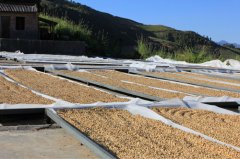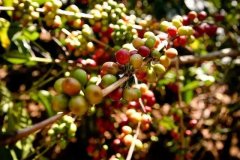Panamanian boutique coffee beans Panamanian rose summer boutique coffee beans boutique coffee bean flavor boutique coffee

Summer Coffee Editor
The species Geisha was discovered in 1931 in Ethiopia's Guisha Forest and sent to the Coffee Institute in Kenya; introduced to Uganda and Tanzania in 1936, Costa Rica in 1953, Panama in the 1970s by Francesco de la Domba Seven Farm. Mr. Serrazin received seed from CATIE in Costa Rica and began planting rosewood coffee, a bean that was hard to come by because yields were so low and he had to compete for it.
Chinese name Summer Rose Coffee Foreign name Summer Rose Coffee Origin Ethiopia
Colour: Blue-green Mouth: floral, tropical fruit, intense sweetness
Profile Editor
The species Geisha was discovered in 1931 in Ethiopia's Guisha Forest and sent to the Coffee Institute in Kenya; introduced to Uganda and Tanzania in 1936, Costa Rica in 1953, Panama in the 1970s by Francesco de la Domba Seven Farm. Mr. Serrazin received seed from CATIE in Costa Rica and began planting rosewood coffee, a hard-won bean because yields were so low and he had to compete.
In 1931, it was exported from Geisha Mountain in southwest Ethiopia to Kenya, Tanzania and Costa Rica in obscurity. It was transplanted to Panama in the 1960s. After nearly half a century, it was amazing. It defeated the ever-winning varieties such as Boben, Kadulla, Kaduai and Tibika, and won the first prize in the 2005, 2006 and 2007 Panama National Treasure Bean Cup Test Competition. In 2007, Rose won the International Famous Bean Cup competition sponsored by the American Fine Coffee Association (SCAA), and the bidding price was $130 per pound, setting a record for the highest price of competitive beans ever. It is reported that the subsequent Panama National Treasure Bean Competition will be divided into two groups: Rose Summer and Non-Rose Summer, so as not to be robbed of the glory of other varieties by Rose Summer. Guixia is a member of the Tibika family, but after leaving Ethiopia for more than 70 years, he has become famous. Moreover, Ethiopia is a treasure trove of Arabica genes. Any donation of a variety abroad is enough to make waves in the coffee market.
Guisha is cultivated in many parts of the world and is the new king of fine coffee. Panama, Guatemala, Colombia and other Latin American countries have higher quality and high price.
Rose summer coffee green beans have a very beautiful blue-green, jade-like warm texture, smell fresh grass, peach flavor, berry flavor and most coffee beans do not have the unique creamy sweet taste of oolong tea, it seems that aroma and taste of this kind of thing is very need to cooperate association, but the light tea gas is we can obviously feel [1].
In order to highlight the characteristics and aroma of this bean, the roasting degree is close to two explosions, close to two explosions and two explosions are more commonly used roasting degrees, so that the characteristics of the bean itself can be brought into play. Too shallow will give off miscellaneous flavor, too deep will lose flower aroma and fruit acid, of course, this should also be adjusted according to the characteristics of the coffee bean and the understanding of the roaster for the bean itself.
Roasted ripe beans, it seems that there will be some "folds", there are "sexy folds" beans are to highlight its original flavor and fruit acid, but if the quality of the raw beans themselves is not high will give some miscellaneous flavor, such as rotten soil flavor, grass flavor and dry flavor, these flavors are baked should try to avoid, baked rose summer has charming lemon citrus aroma and super sweet honey cream flavor.
flavor
Floral, tropical fruit, intense sweetness; these are the feelings that rose summer has always brought us. Properly baked, they make you feel like sipping the fragrance of a bouquet of flowers. In case you haven't heard the story, Rose Summer is an ancient native from Ethiopia that was brought into Costa Rica as a coffee sample and distributed to several small farms for small-scale trials.
Not much attention was paid to the rose until the Esmeralda estate in Panama separated it from the rest and won the national coffee championship.
She's so extraordinary, fruity and floral, it's like a Yega Shefi from Ethiopia, Africa, halfway around the world. Of course, that's old news now. A few small farms are getting summer roses, and eager ones want to grow their own.
However, the results vary, depending on weather, soil and altitude, and the taste of this "star" variety does not seem to be the same in different geographical locations. But in the Actanango region, we see typical rosewood characteristics: slender bean shapes, changes in baking, and elegant, ripened flavors in the cup.
Guixia Coffee
Guixia Coffee
Rosedale's dry nose is very bright, with rose and jasmine floral characteristics, but also can bring out grapefruit and citrus aromas, light toasted nutty aromas; wet nose also has hazelnut flavor, and emerging more floral characteristics. In terms of taste and flavor, the early stage may be slightly mild and subtle compared with the previous aroma, a little cooling, flower and fruit flavor gradually rises with the temperature drop, and the cold aroma is excellent (sweet preserved fruit, rose fruit, orange glaze sauce, strawberry jam, pine flavor, cherry, vanilla, rose gradually fade, and lemon flavor can be derived). This is a coffee that can be praised with a lot of adjectives, back to the sweetness, which is testing the brightness of the coffee, especially in the case of light roasting.
Variety Editor
Panama Emerald Estate
Panama Geisha Hacienda La Esmeralda
In the early years, most of the recognition of top coffee followed Japan, while Geisha swept the coffee world with hurricane-like power. This coffee revolution was fierce, which made the king and queen who had occupied the throne of coffee kingdom for a long time ~ Blue Mountain of Jamaica and Kena of Hawaii have to retreat. This wild variety originally from Ethiopia has been valued in all major coffee producing areas after numerous battles. Its best spokesman is the "La Esmeralda" estate from Panama. Esmeralda Manor's Rosedale coffee is the most famous of the Rosedale varieties.
Panama Emerald Estate
Panama Emerald Estate
In 1924, the Swede Harns. Elliot founded the esmerada farm, which was not a coffee farm but a pasture, 40 years later in 1964. Mr. Bideson's grandfather, Ruth Loveau. M. bideson bought esmerada farm in order to retire and have a place to live, grandfather lut ruff. Born in Sweden, Mr. Bidesson was president of the Bank of America and director of the United Nations Development Programme.
His son Blais. Mr. bidazon moved from california to panama in 1973, inherited his father's farm, changed most of the farm to coffee cultivation in 1987, and purchased machinery for refining coffee in 1994 to create a brand investment. Mr. and Mrs. Bideson raised three children, Eligu (born Philadelphia, 1966), Richelieu (born Sweden, 1967) and Daniele (born Panama, 1974), while the coffee farm was established.
In 1996 Braith and Rachel visited a farm for sale in the Haramijon area of the Boketty Valley and were attracted by the beauty of the farm and immediately bought it. This is Esmeralda? Harami Jonon Farm, third son Danielle. Mr. Bideson planted the coffee world's attention in this farm-Geisha coffee!
Panama rose growing altitude: 1,500-1,650 meters, unique growth environment makes it unique flavor:
Dry fragrance: tea fragrance, flower fragrance (magnolia flower, tulip) vanilla plant, milk fragrance, brown sugar sweet, high champagne and aroma rise.
Wet fragrance: apricot, caramel, milk, flower fragrance.
Sip: Oil texture is good, delicate pear mountain special tea feeling, high-grade white wine astringent but immediately turned into a delicate smooth Body full of mouth.
Berry candy and spice sweet intertwining, accompanied by floral emission, aftertaste full of floral, sweet fruit and body is quite persistent, the lower the temperature, the more delicate the acid.
La Esmeralda has so far won 12 coffee competitions and three online public bidding records: $21 in 2004,$50.25 in 2006 and $130 in 2007! Of course, other countries have also bid a pound of good coffee close to 50 dollars (Brazil CoE champion Fazenda Santa Inês in 2005), El Injerto in 2008 Guatemala CoE champion 80.20 dollars; but you pay attention to the time point, that is, La Esmeralda bid record, before no bid price surpassed her, then, but she will surpass others, saying she is the record maker, no fluke!
Esmeralda Farm Glorious Experience
Panama's highest grade coffee ranked first for four consecutive years in 2004, 2005, 2006 and 2007!
SCAA World Coffee Cup ranking 2005, 2006, 2007 for 3 consecutive years No. 1!
Tropical Rainforest Conservation Group coffee quality cup test ranking 2004, 2006, 2007 No. 1!
Guatemala Summer Rose
Guatemala Acatenango Gesha.
In 2007, Guatemala added an eighth coffee-producing region,Acatenango Valley(R), which we translated as "Acatilan Fruit Region."
In 2007, Anacafé(Guatemala Coffee Association) not only promoted it at SCAA, but also organized a special presentation to international judges during the national competition. In the past, Guatemala claimed to have seven major producing areas, not only to distinguish characteristics, but also to let buyers and consumers good memories, 7 regions of Antigua, the slight plateau, Lake Attitan, Coban rainforest, etc., each area can find excellent manor and good coffee with local characteristics.
Acatenango is located in Chimaltenango province of Guatemala, where more than 5000 hectares of coffee plantations are fertile volcanoes, mainly located in two volcanic mountains, and almost all of them have forests and shade trees. As can be seen from the photos above, almost all of the estates are planted in shade, mainly bourbon and some Catuai and Caturra.
The two volcanoes of Acatenango are Volcan de Fuego and Volcan Acatenango. Acatenango is the third highest volcano in Central America, and beyond Fuego is the lake of Atlantis. Annual rainfall in this area is 48 to 72 inches, annual average temperature is 14 to 31 degrees C, temperature difference is large enough, so the bean density is tight, which is helpful for flavor. Coffee harvest season is mainly from mid January to March. Kaqchiquels still live in the area and maintain traditional farming practices; there are about 4,000 farmers in the area, and coffee cultivation dates back to 1880.
Important Notice :
前街咖啡 FrontStreet Coffee has moved to new addredd:
FrontStreet Coffee Address: 315,Donghua East Road,GuangZhou
Tel:020 38364473
- Prev

Panamanian Emerald Manor Rose Summer Coffee beans Panamanian Fine Coffee beans
The geisha of La Esmeralda became world-famous coffee by accident. Retired Swedish banker Rudolph A. Peterson bought the Jade Manor in Panama to spend his twilight years. Unexpectedly, the coffee trees in the manor bore fruit and sent them to participate in the coffee competition. As a result, they became famous in World War I.
- Next

Panamanian Valentine Manor washing Rose Summer Geisha Aristar production area boutique coffee beans introduction
Affectionate Manor, which covers an area of about 12.5ha, is a miniature estate in Panama. According to the owner, the 8.5ha varieties range from the common typica, Red Catuai and Pacamara. After 2008, a few areas began to grow Geisha coffee, which now accounts for nearly half of the total.
Related
- Detailed explanation of Jadeite planting Land in Panamanian Jadeite Manor introduction to the grading system of Jadeite competitive bidding, Red bid, Green bid and Rose Summer
- Story of Coffee planting in Brenka region of Costa Rica Stonehenge Manor anaerobic heavy honey treatment of flavor mouth
- What's on the barrel of Blue Mountain Coffee beans?
- Can American coffee also pull flowers? How to use hot American style to pull out a good-looking pattern?
- Can you make a cold extract with coffee beans? What is the right proportion for cold-extracted coffee formula?
- Indonesian PWN Gold Mandrine Coffee Origin Features Flavor How to Chong? Mandolin coffee is American.
- A brief introduction to the flavor characteristics of Brazilian yellow bourbon coffee beans
- What is the effect of different water quality on the flavor of cold-extracted coffee? What kind of water is best for brewing coffee?
- Why do you think of Rose Summer whenever you mention Panamanian coffee?
- Introduction to the characteristics of authentic blue mountain coffee bean producing areas? What is the CIB Coffee Authority in Jamaica?

